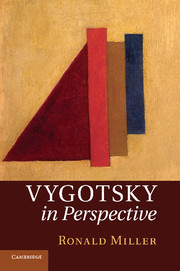Book contents
- Frontmatter
- Contents
- Preface and acknowledgements
- 1 Introduction
- 2 A thematic overview
- PART I Vygotsky at home
- PART II Vygotsky in America
- 7 Michael Cole: artefact-mediated action – setting the record straight
- 8 James V. Wertsch: cultural tools and mediated action – getting it wrong
- 9 James V. Wertsch: mediation and the zone of proximal development
- 10 The essential commentators
- PART III Vygotsky over the rainbow
- Bibliography
- Index
8 - James V. Wertsch: cultural tools and mediated action – getting it wrong
Published online by Cambridge University Press: 21 April 2011
- Frontmatter
- Contents
- Preface and acknowledgements
- 1 Introduction
- 2 A thematic overview
- PART I Vygotsky at home
- PART II Vygotsky in America
- 7 Michael Cole: artefact-mediated action – setting the record straight
- 8 James V. Wertsch: cultural tools and mediated action – getting it wrong
- 9 James V. Wertsch: mediation and the zone of proximal development
- 10 The essential commentators
- PART III Vygotsky over the rainbow
- Bibliography
- Index
Summary
Getting to grips with Wertsch's sociocultural approach (1991, 1995b, 1998) is no easy matter. The difficulty is to pin down the object of this approach or what exactly the approach is designed to explain. Despite the fact that two of his books open with statements about ‘human mental processes’ or ‘mental functioning’, Wertsch is concerned with the phenomenon of action or mediated action as reflected in the titles of his texts: Voices of the Mind: A Sociocultural Approach to Mediated Action (1991); ‘The need for action in sociocultural research’ (1995b); and Mind as Action (1998). The task of understanding Wertsch's arguments is complicated by the fact that he attempts to ground his approach in Vygotskian concepts and uses terminology derived from Vygotsky but in ways that seem to differ fundamentally from the meanings that Vygotsky attributed to these terms, in particular ‘mental functions’, ‘psychological tools’, ‘internalization’ and ‘mediation’. In contrast to Wertsch's emphasis on action, the subtitle Mind as Meaning could be appended to Vygotsky's Collected Works. It is this contrast between mind as action and mind as meaning that sets Wertsch apart from Vygotsky and nothing illustrates the gulf between their theories better than Wertsch's repeated use of the example of pole vaulting to illustrate his concept of mediated action and its properties. In this activity, an individual uses a pole in order to vault over a crossbar and Wertsch regards this as illustrative of mediated human action because the vaulter's action is mediated by the pole and both the pole and the person are necessary components of the activity.
- Type
- Chapter
- Information
- Vygotsky in Perspective , pp. 229 - 280Publisher: Cambridge University PressPrint publication year: 2011



